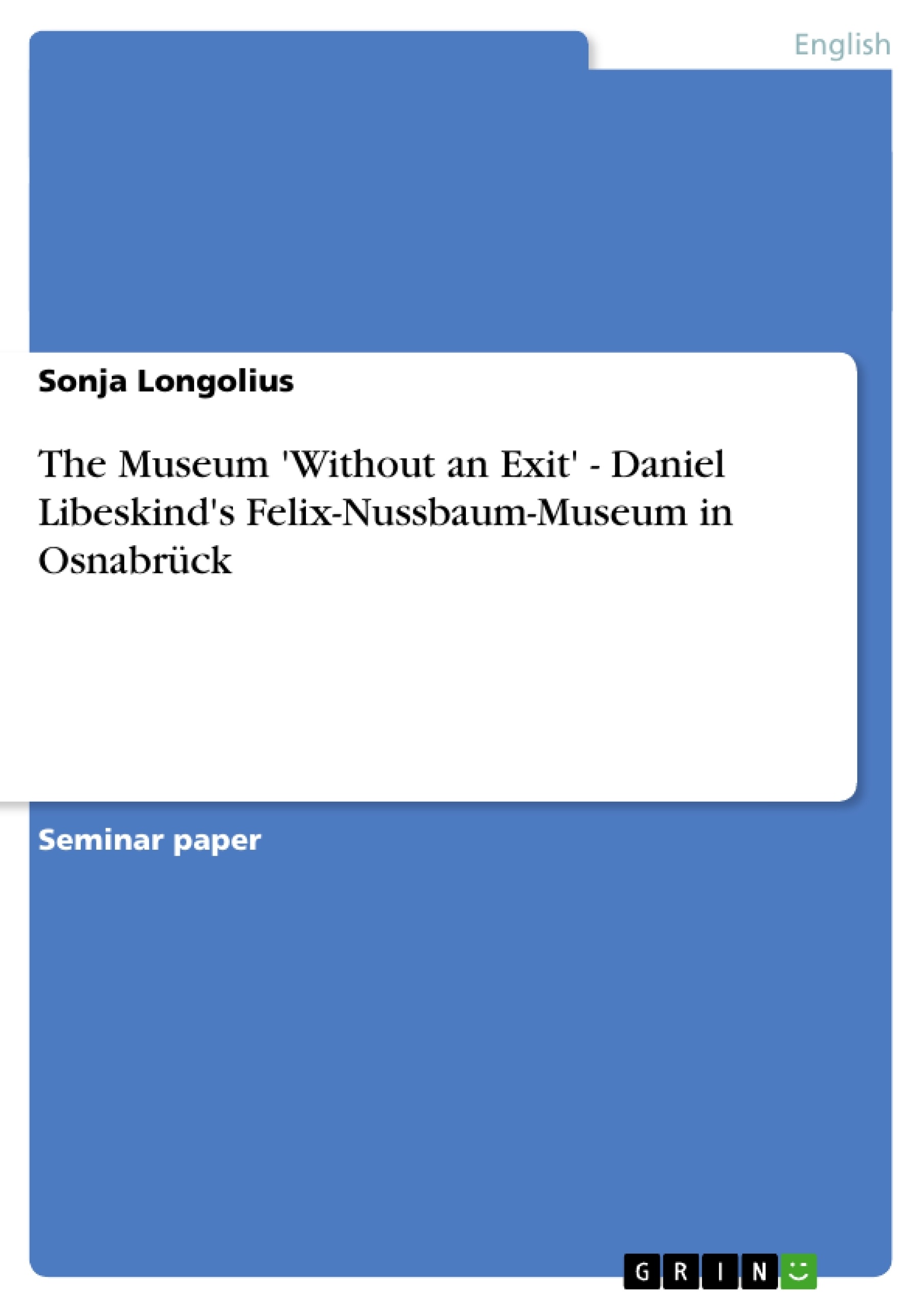Excerpt
Content
1. Introduction
2. Felix Nussbaum – The Painter
3. The Kulturgeschichtliches Museum and its Nussbaum-Collection
4. Daniel Libeskind – The Architect
5. The ‘Museum without an Exit’
5.1 Numbers and Facts
5.2 Passage, House, and Bridge – Three Parts of One Building
5.3 The architectural concept of the ‘Museum without an Exit’
6. Conclusion
7. Bibliography
1. Introduction
“If I perish, don’t let my paintings die, exhibit them!”[1] While speaking these words in his Belgian exile in 1942, Felix Nussbaum did not know that he had only two more years to live until the terror regime of National-Socialism would murder him and his wife – Felka Platek – in Auschwitz. Being only forty years of age when murdered, the artist seemed to have abandoned all hope after being forced to live in exile and under constant threat of discovery since 1933. Nevertheless, this personal hopelessness did not include the destiny of his artwork, for which Felix Nussbaum cared as long as possible.
“The unpainted paintings of Felix Nussbaum demand nothing less than to become visible to the contemplating eye” and so Daniel Libeskind built a museum in Osnabrück to house the largest collection of Felix Nussbaum’s paintings as well as to create “a profound place for the encounter of the future and the past and not only a testament to an impossible fate.”[2] In July 1998 – 54 years after Felix Nussbaum’s deportation to Auschwitz – the museum opened its gates to the public.
The ‘Museum without an Exit’[3], as Daniel Libeskind coined his building, challenges the traditional idea of museums as “Temples of Contemplation.”[4] Daniel Libeskind insists on emotional and physical experiences evoked when entering the museum’s space. His difficult building does not allow visitors to be passive spectators, since the museum does not simply offer space for distributing works of art. Rather, Daniel Libeskind’s building urges people to get closer to the experience of Felix Nussbaum and hence sets new standards in regard of museum-building.
2. Felix Nussbaum – The Painter
Felix Nussbaum was born on December 11th, 1904 in Osnabrück as the second son of a middle-class Jewish merchant-family. Being raised as an assimilated reform-Jew, his early oeuvre seldom includes Jewish themes. Nevertheless, the painting “Die beiden Juden (Inneres der Synagoge von Osnabrück)”[5] reveals his consciousness of an inner “conflict between assimilation and preservation of his Jewish-cultural identity.”[6]
After studying Fine Arts in Hamburg, he moved to Berlin in 1923 to study under Cesar Klein. In 1928 he became a student in Hans Meid’s master class and rented his first studio working and living together with the artist Felka Platek, his later wife. Already in the early 1930s he was an important figure of the young generation of artists in Berlin. Especially his painting “Der tolle Platz”[7], which displays the situation of the arts in 1930s Berlin,[8] contributed to his early success. In 1932 he was granted a scholarship to study at the ‘Deutsche Akademie’ in Rome. Nussbaum never returned to Germany. Being suspicious of the developments in Nazi-Germany after 1933, he extended his stay in Italy. In 1934 he immigrated to Switzerland and one year later he left for Paris only to further immigrate to Belgium.
In exile, Nussbaum painted an impressive amount of paintings despite his artistic isolation. “Art became his medium to analyze his personal experiences”[9] as his best-known painting “Selbstbildnis mit Judenpaß”[10] reveals. After being denounced, Felix Nussbaum and Felka Platek were deported to Auschwitz on July 31st, 1944 on one of the last deportation-trains leaving Belgium.
3. The Kulturgeschichtliches Museum and its Nussbaum-Collection
In 1888/89 Emil Hackländer built the Kulturgeschichtliches Museum Osnabrück to exhibit natural history, art, history, and arts and crafts. Today its exhibition concentrates on regional cultural-history. Two other houses belong to the museum. One is the Schlikker-Villa, a former representative private domicile for the textile-manufacturer Schlikker, which was built by Otto Lüer in 1900/01. Between 1933 and 1945 the villa was the NSDAP-headquarter. Since 1988 it houses the folkloristic department of the museum. The third house belonging to the museum is a classical building from 1871, which functioned as a customs house in the 19th century. Today it offers museum space for smaller, changing exhibitions.
[...]
[1] Felix Nussbaum. Record of Dr. Grosfils – Belgian doctor and art collector – to whom Felix Nussbaum gave his paintings for safekeeping in 1942, in: Hubertus Adam, Kein Ausweg, kein Entrinnen: Daniel Libeskind: Felix-Nussbaum-Haus, Osnabrück, 1995-1998, in: Archithese 5 (1998), p. 26.
[2] Daniel Libeskind, Felix Nussbaum Haus – Museum ohne Ausgang, 25. August 2003 <http://www.daniel-libeskind.com/projects/pro.html?ID=4#more>.
[3] Ibid.
[4] Stephen E. Weil, Beauty and the Beasts – On Museums, Art, the Law, and the Market, Washington D.C., 1983, p. 33.
[5] Felix Nussbaum: The Two Jews (Inside the Synagogue of Osnabrück), 1926, Oil on Canvas, 115x99 cm, Osnabrück, Kulturgeschichtliches Museum.
[6] Inge Jaehner, ‚Wenn ich untergehe, lasst meine Bilder nicht sterben’ Felix Nussbaum – Leben und Werk, in: Vernissage – Die Zeitschrift zur Ausstellung 16 (1999), p. 16.
[7] Felix Nussbaum: The Mad Square, 1931, Oil on Canvas, 97x195,5 cm, Berlin, Berlinische Galerie.
[8] Inge Jaehner, ‚Wenn ich untergehe, lasst meine Bilder nicht sterben’, in: Vernissage 16, p. 22.
[9] Ibid, p. 30.
[10] Felix Nussbaum: Portrait with Jewish Passport, after August 1943, Oil on Canvas, 56x49 cm, Osnabrück, Kunstgeschichtliches Museum.
- Quote paper
- Sonja Longolius (Author), 2003, The Museum 'Without an Exit' - Daniel Libeskind's Felix-Nussbaum-Museum in Osnabrück, Munich, GRIN Verlag, https://www.grin.com/document/41727
Publish now - it's free






















Comments